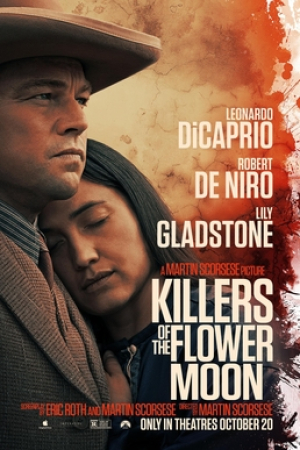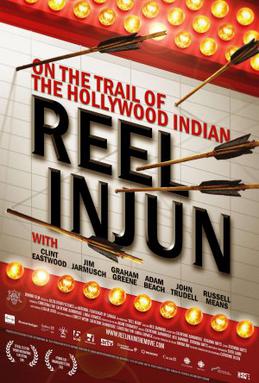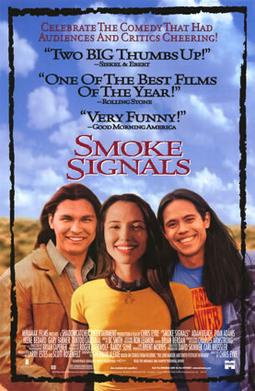
Becoming the Backdrop: The Oppression of Native Americans in Hollywood cinema, and 'Killers of the Flower Moon'
Published in
Films
Killers of the Flower Moon is a recent epic movie set in the 1920s examining a series of murders of members of the Osage Nation, who became wealthy when oil was found on their tribal land. The film is set in Oklahoma (Choctaw language phrase: okla, 'people', and humma, 'red') and depicts the story of a local political boss who was contriving to steal the Osage wealth. The film is long, with a running time of 206 minutes, and shows an ensemble cast of well-known actors such as Leonardo DiCaprio, Robert De Niro, Lily Gladstone, Jesse Plemons, Tantoo Cardinal, John Lithgow, and Brendan Fraser.
It did well, grossing $157 million worldwide as well as receiving critical acclaim, with praise for Scorsese's direction, the screenplay, production values, editing, cinematography, musical score, and cast performances, especially DiCaprio, Gladstone, and De Niro. It was also nominated for ten Academy Awards, including Best Picture; seven Golden Globe Awards, including Best Motion Picture – Drama, and with Gladstone winning Best Actress; nine British Academy Film Awards; and three SAG Awards, with Gladstone winning Best Actress."
The story revolves around Ernest Burkhart (Leonardo DiCaprio) who comes to live with his brother and uncle William King Hale on Hale's reservation ranch after World War I. Hale is a reserve deputy sheriff and cattle rancher who poses as a friend of the Osage while at the same time secretly organising the killing of the Osage through multiple different means such as shooting, poisoning, and even blowing up a house. Ernest Burkhart marries Mollie Kyle, an Osage whose family owns oil headrights.
It did well, grossing $157 million worldwide as well as receiving critical acclaim, with praise for Scorsese's direction, the screenplay, production values, editing, cinematography, musical score, and cast performances, especially DiCaprio, Gladstone, and De Niro. It was also nominated for ten Academy Awards, including Best Picture; seven Golden Globe Awards, including Best Motion Picture – Drama, and with Gladstone winning Best Actress; nine British Academy Film Awards; and three SAG Awards, with Gladstone winning Best Actress."
The story revolves around Ernest Burkhart (Leonardo DiCaprio) who comes to live with his brother and uncle William King Hale on Hale's reservation ranch after World War I. Hale is a reserve deputy sheriff and cattle rancher who poses as a friend of the Osage while at the same time secretly organising the killing of the Osage through multiple different means such as shooting, poisoning, and even blowing up a house. Ernest Burkhart marries Mollie Kyle, an Osage whose family owns oil headrights.

Lily Gladstone's portrayal of Mollie Burkhart garnered critical acclaim, earning her a nomination for the Academy Award for Best Actress
Mollie decides to go to Washington and asks President Calvin Coolidge for help in solving the murders. Bureau of Investigation (the eventual FBI) Agent Thomas Bruce White Sr. and his assistants are sent to Oklahoma to find out who is behind the murders. White finds out the truth and persuades Ernest to confess his involvement and testify against his uncle Hale. Hale and Ernest are sentenced to life imprisonment but both were paroled after years of incarceration, despite Osage protests to the parole board.
Killers of the Flower Moon has themes which differ from traditional Westerns in that the 'cowboys' are focused on oil production and resent the community that owns the rights to oilfields. It is also different in that law and order is controlled not by the local sheriff [who is corrupt in this case] but by the federal state who sends in its agents to find out what is going on. This twentieth century concept of the developing power of the state taking over from the nineteenth century local power of the sheriff is only the start. The newly developed FBI launches into containing local criminality with all the power and forces of the federal state. The FBI went on to be involved in the capture and deaths of numerous infamous mobsters of the day, including John Dillinger, Pretty Boy Floyd, Baby Face Nelson and Machine Gun Kelly.
The Osage case is also depicted in the 1959 American crime drama film, The FBI Story, showing how the FBI developed from a detective agency to an enforcement agency with the statutory authority to carry guns and make arrests:
The FBI was compelled to investigate after one of the [Osage] murders was committed on federal government land. The FBI forensics laboratory ties the doctored wills and life insurance policies of the murder victims to a local banker, Dwight McCutcheon, with the typewriter that he used.
Native Americans and Hollywood cinema
In Killers of the Flower Moon Martin Scorsese had originally intended that Leonardo DiCaprio would play the FBI agent who solves the crimes. However screenwriter Eric Roth began to fear the story underplayed the experience of the Osage people and repeated tired tropes. "We didn't want to go much further with this Great White Hope saving Native Americans," says Roth. This fear of stereotyping led to Scorsese meeting with members of the Osage community in Pawhuska, Oklahoma, including Chief Geoffrey Standing Bear, the principal chief of the Osage Nation.
Hollywood has had a long history of depicting Native Americans in cinema. The Cree filmmaker Neil Diamond covers a century of the portrayal of North American Natives in his documentary Reel Injun:
Reel Injun explores the various stereotypes about Natives in film, from the noble savage to the drunken Indian. It profiles such figures as Iron Eyes Cody, an Italian American who reinvented himself as a Native American on screen. The film also explores Hollywood's practice of using Italian Americans and American Jews to portray Indians in the movies and reveals how some Native American actors made jokes in their native tongue on screen when the director thought they were simply speaking gibberish.
In Killers of the Flower Moon Martin Scorsese had originally intended that Leonardo DiCaprio would play the FBI agent who solves the crimes. However screenwriter Eric Roth began to fear the story underplayed the experience of the Osage people and repeated tired tropes. "We didn't want to go much further with this Great White Hope saving Native Americans," says Roth. This fear of stereotyping led to Scorsese meeting with members of the Osage community in Pawhuska, Oklahoma, including Chief Geoffrey Standing Bear, the principal chief of the Osage Nation.
Hollywood has had a long history of depicting Native Americans in cinema. The Cree filmmaker Neil Diamond covers a century of the portrayal of North American Natives in his documentary Reel Injun:
Reel Injun explores the various stereotypes about Natives in film, from the noble savage to the drunken Indian. It profiles such figures as Iron Eyes Cody, an Italian American who reinvented himself as a Native American on screen. The film also explores Hollywood's practice of using Italian Americans and American Jews to portray Indians in the movies and reveals how some Native American actors made jokes in their native tongue on screen when the director thought they were simply speaking gibberish.

Reel Injun film poster
Scorsese was obviously aware that to be taken seriously today he would have to involve the Osage Nation in the making of this film. This story involved an extraordinary situation for Native Americans anywhere in North America, as the Osage directly benefited from the natural resources of their territory.
"I was anxious," Scorsese says. "I knew that if I could not gain their trust, then there's no sense in making the film. As a European American, a Sicilian American, I may have natural limitations, and I hoped that they would forgive that. But they had to know it was coming from the right place and not a surface revisionism, which is simplistic. I wanted something really, really complex that deals with humanity." [...] "One of the people in the room said, 'You have to be very careful. You're putting words in the mouths of people that ... These are real people to us. They're part of our families.' "
The depiction of the Native Americans from the early cinematic beginnings emphasised violence, vacillating from violence to be admired to violence to be feared, depending on the ideological needs of each decade in the twentieth century. When America was under internal or external threat then the violence of the 'Injun' was to be feared. When America needed a strong identity, a powerful role model of the fearless warrior, then the Native American was to be admired. In either case the violence provides catharsis for the colonising power. Even though it is the Native Americans that are being depicted, their needs are secondary.
Many white actors played Native American roles and had no concern for Native American opinions about their roles. "White people playing native roles? I love it, 'cos it's funny!" says Cheyenne/Arapaho filmmaker, Chris Eyre, in Reel Injun. Native Americans were played by Burt Lancaster, Charles Bronson, Burt Reynolds, Elvis Presley, Boris Karloff, Anthony Quinn, Chuck Connors, Daniel Day-Lewis, Sylvester Stallone, Pierce Brosnan, Johnny Depp and others.
In Smoke Signals, a 1998 coming-of-age comedy-drama film directed by Chris Eyre, there is an awareness of the Romanticist portrayal of the Native American as a hero for white audiences. Similarly, white heroes were seen as belonging to the colonial cultural mindset. In Smoke Signals, Thomas Builds-the-Fire argues: "Nobody can help us. No Superman. No Batman. No Wonder Woman. Not even Charles Bronson, man." (Reel Injun)

Smoke Signals film poster
Killers of the Flower Moon tells a Native American story and is even populated with Osage actors - yet it is still a white man's story, paid for and dominated by, white actors. While it is difficult for any group to tell their story, especially in an expensive medium like cinema, it is even more difficult to imagine the dominant group/oppressor telling your story. Can we expect the British to make radical films about Irish uprisings against British rule? Can we expect the Israelis to make films about the Palestinian struggle against settler land grabs?
Killers of the Flower Moon tells a Native American story and is even populated with Osage actors - yet it is still a white man's story, paid for and dominated by, white actors. While it is difficult for any group to tell their story, especially in an expensive medium like cinema, it is even more difficult to imagine the dominant group/oppressor telling your story. Can we expect the British to make radical films about Irish uprisings against British rule? Can we expect the Israelis to make films about the Palestinian struggle against settler land grabs?
This is not to say it is impossible, or to object to others telling the stories. Two of the best movies made about recent Irish history were made by British directors: The Wind That Shakes the Barley (2006) by Ken Loach and Hunger (2008) by Steve McQueen, covering the Irish War of Independence and the 1980s Hunger Strikes respectively. However, ultimately the victims are the best to tell their own stories, for nuance and perspective on the oppressor. This is arguably because the oppressor ultimately always makes the story about themselves, trying to deal with their past shame - assuming, of course, that their narrative is sympathetic to the victims and not the oppressors.
The missing analysis of structural oppression
However, the feeling of being a helpless bystander persists. As Jesse Wente, a Ojibway film critic, remarks about Dances with Wolves (1990), one of the most successful films about the American West:
The natives were fleshed out as characters, allowed to be seen as more complete people. They weren't just warriors; they weren't just peaceful. There was a very sensitive and sympathetic approach. It doesn't erase the fact that at it's core the film is not a native movie. It is still a movie made from the outside of us and it's about us and is meant to be sympathetic towards us. But, it isn't us. It's a story about a white guy. And, Indians are the T and A, but it gets promoted as being about native people or Indians, but it's not, really. We're just backdrop. (Reel Injun)
The natives were fleshed out as characters, allowed to be seen as more complete people. They weren't just warriors; they weren't just peaceful. There was a very sensitive and sympathetic approach. It doesn't erase the fact that at it's core the film is not a native movie. It is still a movie made from the outside of us and it's about us and is meant to be sympathetic towards us. But, it isn't us. It's a story about a white guy. And, Indians are the T and A, but it gets promoted as being about native people or Indians, but it's not, really. We're just backdrop. (Reel Injun)
What is missing is an analysis of structural oppression that exists in economic, legal and social forms in society and the ways in which people experience oppressive conditions in their daily lives. That oppression is defined as structures of domination and oppression that gives other groups the power to determine one's actions. Thus,
Individuals experience oppressive conditions because they are part of a group that is defined on the basis of shared characteristics such as race, class, gender, ethnicity, sexuality, nationality, age, ability, etc. These major social groups have specific attributes, stereotypes and norms associated with them.
In 'Five Faces of Oppression', Iris Young discusses five types of oppression: exploitation, marginalization, powerlessness, cultural imperialism, and violence. Under the heading of Exploitation, Young discusses the question of the ownership of the means of production and the necessity for labour power. If you are the owner you gain from the profit generated from the production. In the case of the Osage they gained royalties from oil licensing not from oil extraction which required ownership of the equipment to do so. Therefore they received a small portion of the profits accrued.
In terms of Marginalization, Native Americans on reservations are marginalized by high unemployment rates and limited opportunities to develop marketable skills.
Under the heading of Powerlessness, different types of jobs confer levels of status on their employees. When we combine status with class, "most people of color have to prove their social respectability –– it is not assumed or automatically granted."
Under Cultural Imperialism "cultural dominance refers to the way that one group's experiences, cultural expressions and history are defined as superior to all other groups' experiences and histories." In this narrative of the 'helpless' Osage community the dominant view of justice is to find out who is doing the killing, which in turn, justifies the 'universalist' idea that one is living in a community that 'cares'.
The last heading, Violence, covers two types of structural violence: state-sanctioned racial segregation backed up by violence, and the range of violent tactics used against the Osage that is based on knowledge power controlled by elites, for example, new medicines and explosives.
In this way we can see how institutions and those with power work together with individual attitudes rooted in white privilege, patriarchy, and capitalism to keep the working class poor, while at the same time, allow the wealthy to maintain and increase their capital accumulation.
The people's own social and cultural movements towards freedom
These issues will never be resolved within a system and ideology that only discusses distributive issues and never discusses such basic fundamentals as the ownership and control of the means of production. This is where the transition in thinking from capitalist ideology to socialist ideology becomes essential.
In the meantime, films like Killers of the Flower Moon are a step in the right direction in that the involvement of groups on the margins in major cinematic productions encourages confidence and desire to see more. The possibility of a cinema that not only looks at marginalised histories but also writes into the narrative a demonstration of the structural aspects of oppression is always potentially on the horizon, especially as the means of production in cinema become cheaper to obtain and use, and more accessible to ordinary people.
As Killers of the Flower Moon depicts a Native American story and uses Native American actors, it could and should inspire Native Americans to make their own independent films that include a structural analysis. I don't think we can ever expect Hollywood to make such films, as the American neocon and militarised state is so embedded in the Hollywood system. In the end, a new cinema will have to arise from the people's own social and cultural movements towards freedom, filling a vacuum created by the contrast between Hollywood fantasy and stark social realities.
